
There was perhaps an unexpected confidence to be observed when the 2025 edition of EXPO Chicago opened its VIP preview on Thursday, April 24th. Despite lingering anxieties over tariffs and broader stock market volatility, the mood at Navy Pier was one of relative buoyancy. “There’s always been a little bit of a fearlessness to Chicago collectors,” said Tony Karman, the long-time president of the fair. “They want to learn, and they’re not afraid to ask questions. They’ll take risks on new work.” In the face of trepidation, Karman invoked the civic mantra: “Chicago is the city that works,” adding that, in this particular case, it is working as “a city for the artists.”
The 12th edition of the fair, on view through April 27th, is the second held under the ownership of art fair conglomerate Frieze, which is largely seen in the changes to EXPO’s programming. Most notable at this year’s edition are the 20 Korean galleries participating in a special collaborative program with the Galleries Association of Korea (GAoK). The initiative draws on the synergy between Frieze’s Seoul fair and its concurrent neighbor KIAF Seoul, adding a global dimension to the fair’s typically regional foundation.
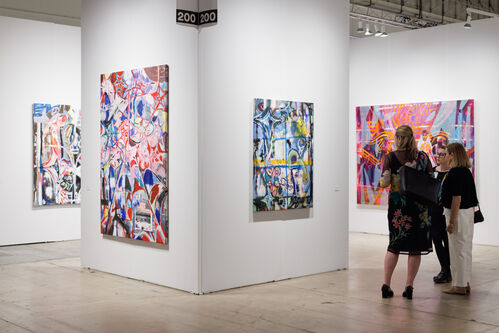
“We probably would have never been able to manifest anything close to a 20 gallery special section, and that happened because of discussions that took place because of the relationships with Frieze,” said Karman. “There’s this history of Korean galleries that have done a Chicago fair, not just EXPO Chicago, but past iterations of fairs in Chicago. So, it wasn’t odd for the Korean Gallery Association to return to a city that for decades has hosted and allowed Korean galleries to be successful.”
At the VIP preview, a local-leaning crowd of collectors, curators, artists, and students packed the aisles, giving the opening hours a tone that felt both buzzy and informal. The fair features more than 170 leading galleries from 36 countries, and this year’s edition includes over 50 first-time exhibitors, furthering a sense of renewal in the familiar architecture of the Navy Pier. This was reflected across booths at the fair, where several exhibitors took an emboldened approach to their presentations. “Galleries [are being] true to their program and not afraid to bring work that’s challenging, provocative, and equally as beautiful,” Karman said.
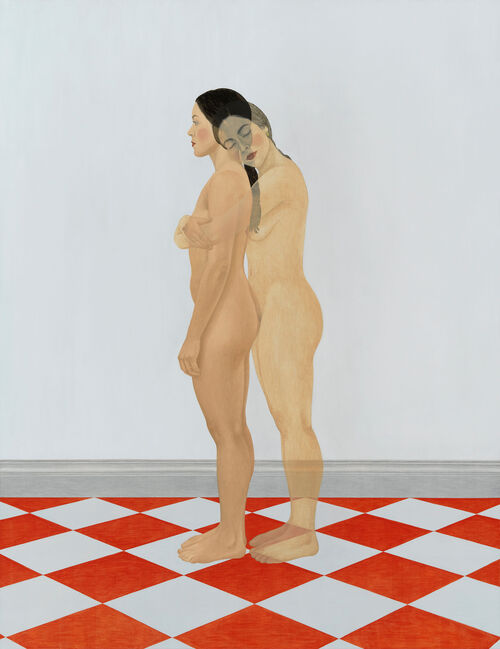
Feelings, 2023
Jeffly Gabriela Molina
SECRIST | BEACH
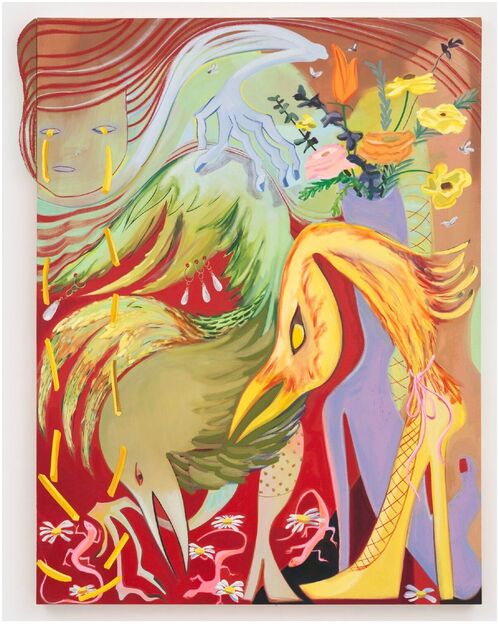
Polite Poultry Fight Swayed by Wendy’s Windstorm, 2024
Chelsea Culprit
SECRIST | BEACH
Indeed, this approach was exemplified at the booth of SECRIST | BEACH, the Chicago gallery co-founded by ex-financier Bill Beach and art dealer Carrie Secrist. One half of the booth was devoted to “Master Class: Inside the Last American Museum School,” a presentation tied to their current exhibition in the city’s West Town, featuring work by painting and drawing alumni from the School of the Art Institute of Chicago (SAIC) spanning 2000 to 2025. This includes works such as Jeffly Gabriela Molina’s intimate portrait of two naked women, Feelings (2023), priced at $16,000. For Beach, this type of institutional-oriented presentation is “a litmus test for the market,” noting that several works had already sold during the preview. “I feel there’s a break the other way,” he added.
That same sense of optimism was particularly prevalent across the visiting Korean galleries, and several embraced emotional resonance as a counterweight to economic tensions in their presentations. Seoul’s EVERYDAY MOONDAY, for example, presented a solo exhibition of 45-year-old Korean artist Moonassi, featuring a selection of ink and acrylic paintings on Korean hanji paper, priced from $7,000 to $18,000. The gallery chose to bring the artist’s introspective drawings to the fair with the sense that collectors “tend to prioritize emotional and conceptual value,” according to director Diny Lee. In times of tension and uncertainty, Lee added, “Art that offers reflection and emotional clarity often becomes priceless.”
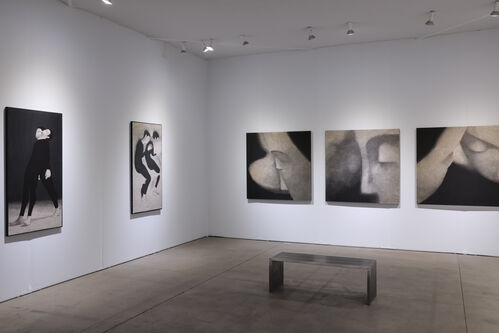
For many of the international galleries in attendance, it wasn’t a completely stress-free journey to Chicago. Ashley Kim, assistant manager of Seoul-based Suppoment, acknowledged the complications posed by tariffs (art, it should be noted, is broadly understood to be exempt from tariffs) and broader uncertainty, particularly as the gallery made its EXPO debut. Still, the decision to participate felt like a natural one: The gallery previously maintained an office in Chicago and saw value in returning to the city with a focused presentation. The booth featured works by three Korean artists associated with the 1970s Dansaekhwa movement: Lee In Seob, Yoo Mi Seon, and Lee Soo Hong.
“[These artists] want to highlight that not everything you experience has to be good,” Kim said. “It’s like how light and dark work—because there are dark moments, you come to appreciate the light, and vice versa.” That sensibility was especially present in Lee In Seob’s Untamed; grains of time (20250212) (2025), the most expensive piece in the booth, priced at $65,450, which layers gestural strokes of cobalt blue and taupe over a textured white ground, evoking a meditative tension between contrast and calm.
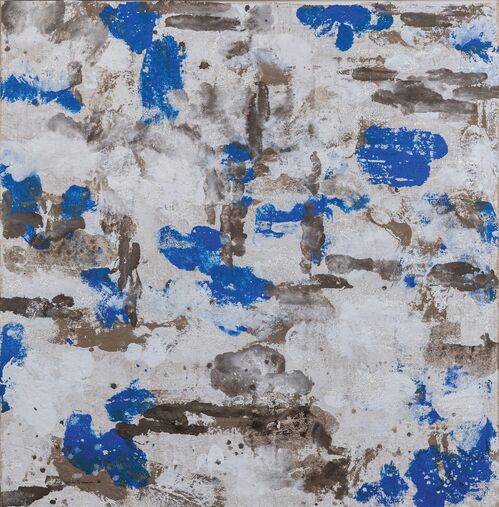
Untamed; grains of time (20250212), 2025
Lee In Seob
Suppoment Gallery
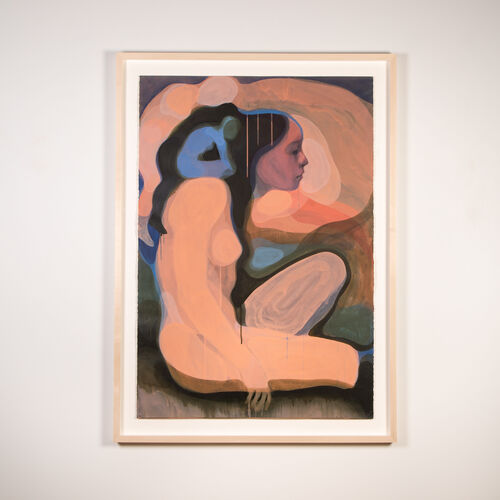
Les poupées russes , 2024-2025
Magali Cazo
Wishbone
Other exhibitors, meanwhile, approached the fair with a touch of trepidation towards the Trump Administration, but found their worries quelled in the first few hours of the fair. Michael Lewin of Montreal-based gallery Wishbone told Artsy, “Obviously, we had a lot of concern going into an American fair from a Canadian perspective, but the reception we’ve received has just been warm and lovely.”
Everything on view at the gallery’s booth is priced under $10,000, including work by French artist Magali Cazo—large-scale ink-on-paper landscapes and nudes—and Chicago-born, L.A.-based artist Mia Weiner, whose silk and cotton tapestries explore themes of femininity and sensuality with quiet intensity. Lewin said he wanted to bring works to Chicago “without the sort of bravado that one would find in the Miami market or in the New York market.” To him, EXPO is “a lot more down to earth.”
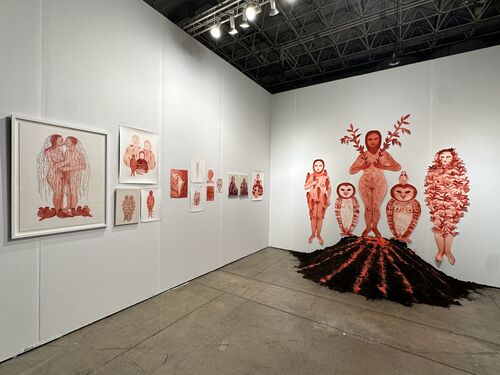
This preference for emotionally resonant work carried over to San Francisco–based re.riddle, which made its EXPO debut with a presentation by Paris-based Mongolian artist Odonchimeg Davaadorj. With prices ranging from $800 to just over $6,000, the booth included red watercolor works on paper and a commanding installation: five large-scale, red-toned figurative cutouts depicting a nude woman, flanked by two owls and two shorter figures, set above a mound of red-streaked dirt. The result was raw, symbolic, and a refreshing approach to a booth presentation.
“We decided to bring this body of work because it is conceptually robust,” said the gallery’s founder, Candace Huey. “We were informed that Chicago appreciates and understands conceptual rigor and intellectual challenges. Our programming is always thinking about contemporary art discourse, and Chicago plays a heavy role in that and in shaping those narratives.”
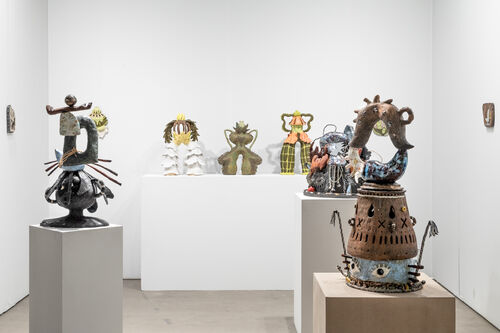
Other galleries are approaching EXPO with a slower, more meditative rhythm. Los Angeles’s Megan Mulrooney, also making its debut at this year’s fair, is presenting a two-person ceramics booth from Maddy Inez and Josh Cloud, rooted in themes of healing. Inez—the granddaughter of Betye Saar and daughter of Alison Saar—presented glazed ceramic works inspired by the matilija flower, a species of poppy that only germinates in the presence of smoke. Created in response to the California wildfires, her compositions reflected the idea of beauty emerging from devastation. Cloud’s works—ceramic structures that appear to be collaged together—reflect on queerness and identity, complementing the emotional register of the booth.
“There’s something beautiful about talking about plants and healing…in the face of such devastation and aggression,” said Mulrooney. “People understand that given the tumultuous world, it’s really nice to speak about art and talk about art, to give voices or shed light on voices that are misrepresented or not heard.”
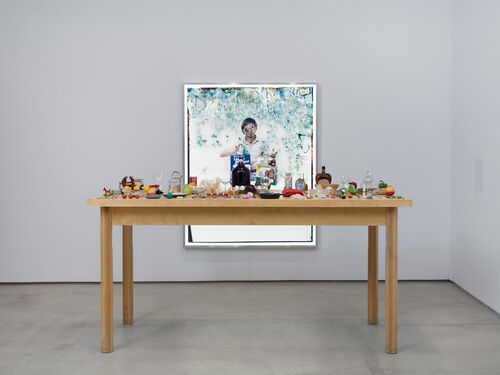
Untitled Prop Archive (THE PORTFOLIO), 2024
Amanda Ross-Ho
ILY2
The appetite for experimentation from galleries across the fair found its sharpest edge at Portland-based ILY2’s booth. The presentation was anchored by Amanda Ross Ho’s Untitled Prop Archive (THE PORTFOLIO) (2024): a sculpture composed of dozens of objects inspired by items—from licence plates to lemons—found in the photo archive of her father, Ruyell Ho. These items were arranged on an enlarged replica of the wooden table from her childhood home, standing in front of a water-damaged portrait of Ruyell.
The presentation originated from director Jeanine Jablonski, who, while scouting the fair last year, was struck by feedback that photography—and photography-based work—was noticeably underrepresented. Alongside Ho’s work, the gallery decided to bring photography and photo-based works by Morgan Buck, Melanie Flood, and Timothy Yanick Hunter—some hung in pink frames around the booth, priced from $2,200 to $65,000.
“Right now is the time where if you can take risks, it’s time to take a risk,” Jablonski told Artsy, summing up the mood shared by many at EXPO. “When things are unstable, it’s the time to do the weirdest shit.”
+ There are no comments
Add yours